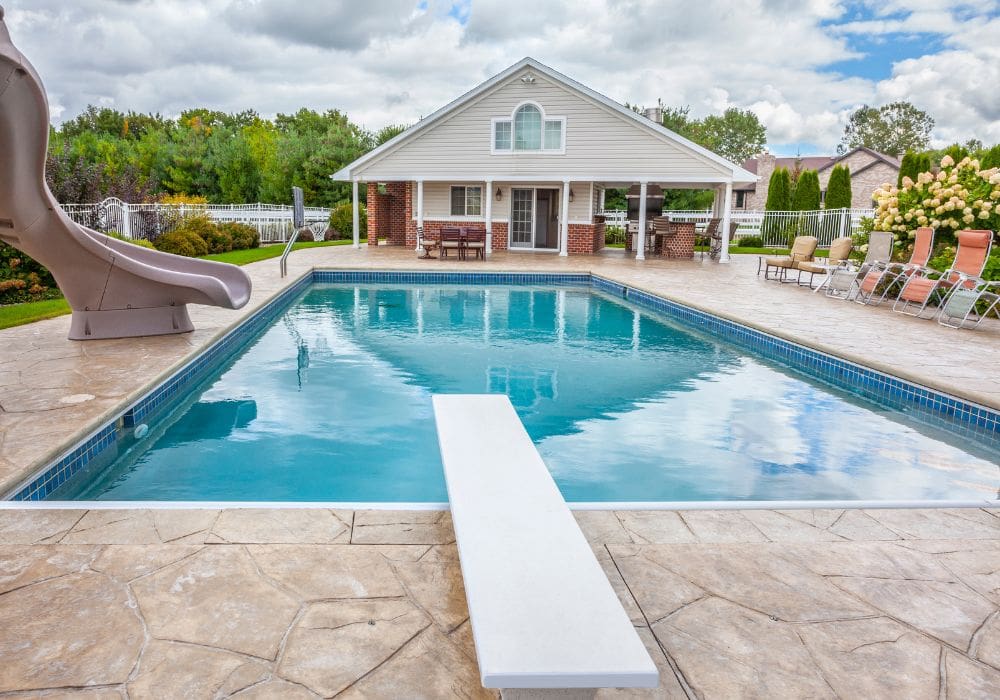
How to Close an Inground Pool – RMD Pool Service
If you’re wondering how to close an inground pool for winter, don’t worry—you’re not alone! Closing your pool properly is crucial to protect it during the colder months, prevent costly repairs, and make opening it in spring much easier. At RMD Pool Service, we’re here to guide you through every step of winterizing inground pool, ensuring you get a smooth and stress-free closing experience. Here’s our simple, practical guide to closing your inground pool for winter, designed to give you confidence in the process.
Step 1: Clean Your Pool Thoroughly
The first step of winterizing swimming pools in ground is to clean them.
Not cleaning the pool thoroughly can lead to the buildup of algae and bacteria over winter, which can be a hassle to deal with when you reopen your pool. It’s important to remove any leaves, dirt, and other debris to prevent this from happening.
- Weekly pool maintenance is helpful, but for closing pool for winter, go deeper. Use a pool cleaner or shop vac to remove dirt.
- Thoroughly brush the pool walls and vacuum the floor.
- Consider a stain chemical treatment to remove any stains.
Step 2: Balance the Water Chemistry
Before you close an inground pool, make sure the water chemistry is balanced. Proper pH, alkalinity, and calcium hardness levels protect your pool equipment and help keep the water clear.
- Keep the pH around 7.2 to 7.6 and alkalinity at 80 to 120 ppm.
- Shock the pool with a bit of extra chlorine to kill bacteria.
- Add algaecide to prevent algae.
- Adjust alkalinity using baking soda if needed.
Step 3: Lower the Water Level
To avoid freezing and cracking, lower the water level in the pool below the skimmer and returns. This step on how to close an inground pool prevents water from getting into the lines.
- A submersible pump or shop vac can help with draining.
- Lower the water roughly 4-6 inches below the skimmer.
Step 4: Drain Pool Equipment and Lines
One of the most important steps in how to clean an inground pool is draining water from the pump, filter, heater, and plumbing lines. Water left in these parts can freeze and cause damage.
- Backwash the filter to clear it out.
- Drain the pump, heater, and filter completely.
- You can use an air compressor or shop vac to blow water out of the lines.
If you’re unsure about this step on how to close an inground pool, RMD Pool Service offers drain and cleaning service options to handle it for you.
Step 5: Add Winterizing Chemicals
Adding winterizing chemicals to your inground pool helps keep the water clear and clean through the winter months. These chemicals reduce algae growth, staining, and scaling.
- Use algaecide to control algae.
- Add a shock treatment for extra bacteria protection.
- Consider using a stain prevention product to keep your pool looking great.
Step 6: Cover Your Ground Pool
A strong pool cover is key to keeping out leaves, dirt, and sunlight that can cause algae. Pool covers come in different types, but a safety cover that fastens tightly is usually the best option for winter.
- Secure the cover to avoid debris slipping underneath.
- Use water bags along the edges if needed to keep the cover in place.
We recommend high-quality pool covers to make winter care as easy as possible.
Step 7: Store Pool Equipment and Accessories
Any pool accessories, like ladders, hoses, and pool cleaners, should be stored in a dry area. This step on how to close an inground pool keeps the accessories in good shape and ready to use when you reopen your pool.
- Store your pool chemicals in a cool, dry place, and away from direct sunlight.
- Inspect accessories for damage to see if replacements are needed before next season.
Extra Tips for Winter Pool Care
- Check your pool cover now and then to make sure it’s secure and clean.
- Remove any snow or rain that builds up on the cover to avoid extra weight.
- Keep in mind that pool equipment repair and skimmer replacement are much easier to avoid if you properly close and winterize your pool.
Why Closing Your Inground Pool Matters
Knowing how to prepare a pool for winter the right way saves you time and money in the long run. Winterizing keeps the water clean, prevents algae, and helps avoid damage to pool equipment like the pump, skimmer, and filter. By doing the seven winterize inground pool steps, you’ll protect your pool and make reopening a breeze.
Need Help in How to Close an Inground Pool? Contact RMD Pool Service
Closing an inground pool for winter can seem overwhelming, but you don’t have to do it alone. RMD Pool Service offers everything you need, from weekly pool maintenance to filter cleaning service and pool equipment repair. Let us handle the work so you can rest easy knowing your pool is well-protected, giving you peace of mind during the winter months.
Give us a call for closing and winterizing assistance or to set up a service appointment for next season. We’re here to ensure you get the most out of your pool with minimal hassle.
Remember, closing your inground pool correctly will help it stay in great shape during the winter months, saving you time and hassle come spring. Enjoy your winter with peace of mind, knowing your pool is safe and sound until next season!
Frequently Asked Questions About How to Close an Inground Pool
1. Why is it important to know how to close an inground pool properly?
Closing your inground pool properly prevents costly repairs, protects pool equipment, and keeps your water clean throughout winter. We can help with every step.
2. What happens if I skip balancing the water chemistry before closing my pool?
If you don’t balance the water chemistry, you may face algae growth, cloudy water, and even damage to your filter and heater. Balanced water is essential for a successful winter close.
3. How low should I drain the water in my inground pool before winter?
Drain the water 4-6 inches below the skimmer to prevent water from entering the lines and freezing. If you’re not sure, RMD Pool Service offers help with all your winterize inground pool steps.
4. What chemicals are needed for winterizing my pool?
To winterize an inground pool, you’ll need algaecide, a shock treatment, and possibly a stain prevention product. These help maintain water clarity and prevent scaling.
5. Do I need a pool cover for winter?
Yes, a pool cover keeps out leaves, dirt, and sunlight, which can promote algae growth. A well-secured safety cover is ideal for winter months.
6. How can I prevent my pool’s plumbing from freezing over winter?
Drain water from the pump, filter, heater, and lines, and use an air compressor or shop vac to clear them. Proper draining helps avoid damage from frozen water.
7. Should I remove pool accessories before closing my pool?
Yes, store all pool accessories, such as ladders, hoses, and pool cleaners, in a dry place. This will prevent damage and keep them ready for next season.
8. What can I do if I notice debris building up on my pool cover?
Periodically check and clean off any snow or rain from your pool cover to prevent excess weight, which could damage it.
9. How often should I inspect my pool during winter?
Check your pool every few weeks to ensure the cover is secure and the water is clear. This helps you find any potential issues early.
10. What if I’m not comfortable closing my inground pool myself?
No worries! We at RMD Pool Service can help with every step.
Winterizing your swimming pool is essential for a worry-free spring opening. Let RMD Pool Service in Allen, TX handle your inground pool closing and protect your pool with expert care. Contact us today to schedule your service and keep your pool in shape!
